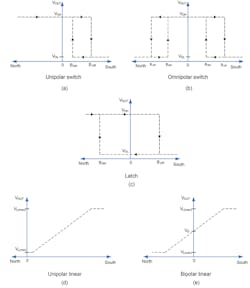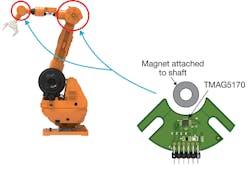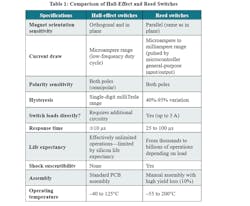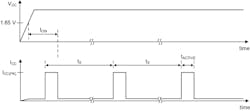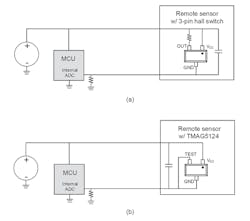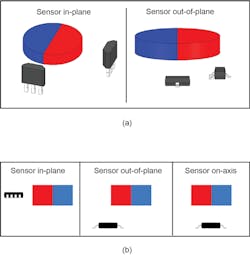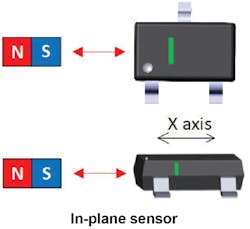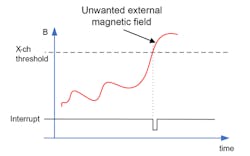What you’ll learn:
- The difference between Hall-effect sensors and Hall elements.
- Why Hall-effect sensors provide more than on and off information.
- How Hall-effect sensors can detect magnetic fields from an extended range.
For many years, designers have used Hall-effect sensors in industrial and automotive systems for proximity detection, linear displacement measurements, rotary encoding, and many other applications. Over time, higher system performance demands have pushed integrated-circuit (IC) providers to increase sensitivity accuracy, integrate more functionality, offer different sensing directionalities, and lower power consumption, extending the use of Hall-effect sensors for decades to come.
This article will examine common misconceptions regarding Hall-effect sensors and tie in real-world applications when appropriate.
1. Hall-effect sensors provide only simple on and off information.
Many electromechanical designs require the detection of an object with a sensor, which provides a simple logic signal indicating its presence or absence. One example is the closing and opening of a laptop lid, indicating when to power it on or off. Another example is an intrusion event in a door and window sensor. These applications typically use a simple Hall-effect switch that toggles its output voltage once an internal magnetic threshold has been crossed.
While those Hall-effect switches are very useful, they’re not the only type of Hall-effect sensor available—latches and linear devices also are quite common. In contrast to a switch, a latch, which is mainly used in rotary encoding, will toggle its output only in the presence of an opposite magnetic polarity to what it had previously experienced.
For precise displacement measurements, linear Hall-effect sensors are preferable because they can define, with high resolution, where an object is relative to the sensor. In other words, they provide much more than on and off information. Figure 1 illustrates the transfer functions for each type of sensor, including the variations available.
2. Linear Hall-effect sensors are not accurate.
Linear Hall-effect sensors are without question cost-effective solutions that provide reliable magnetic information. Users of such sensors know this fact, but often consider other technologies to meet their high-accuracy requirements.
In industrial robotics, for example, the moving arms must be precisely positioned in relation to the target object. Using a high-accuracy, linear 3D Hall-effect sensor such as the TMAG5170 from Texas Instruments (TI) offers the precision needed for such applications (Fig. 2). Furthermore, the device’s high precision and low-sensitivity drift over temperature potentially eliminates the need for system-level calibration.
3. Hall-effect sensors are the same as Hall elements.
It’s simply not true that Hall elements are essentially the same as Hall-effect sensors. The Hall element, which requires bias circuitry and a differential amplifier, is the most basic structure needed to produce a usable voltage. In contrast to Hall-effect sensors, Hall elements don’t have all supporting circuitry integrated into a single package.
Figure 3 shows the circuit implementation for both types of sensors. Hall elements are typically used in applications where accuracy isn’t critical, cost is extremely important, and a differential amplifier is nearby to minimize external noise coupling. In addition, Hall elements have an inherent nonlinear variation over temperature, while Hall-effect sensors have built-in compensation to ensure stable measurements across a wide temperature range of −40 to 125°C.
For more information about Hall-effect sensors, see the TI E2E design forums article, “What is a Hall-effect sensor?”
4. Hall-effect switches are not useful replacements for reed switches.
Reed switches are still prevalent today in many applications, such as door and window sensors. The main drawback to using reed switches in security alarm systems is the inability to detect a tampering event. By using a linear 3D Hall-effect sensor, designers can take advantage of any channel not used for active measurement to detect this event.
Another example is in a refrigerator door to control the exact position, where the inside light is turned on or off. Hall-effect switches offer consistent open-and-close distance detection given their tight threshold hysteresis specifications.
A second major drawback to using reed switches is their inability to use standard printed-circuit-board (PCB) assembly procedures. These devices must be hand-soldered onto the board, thus complicating the assembly process and increasing costs. Table 1 compares the two technologies.
5. Low-power solutions are not achievable with Hall-effect sensors.
While it’s true that some Hall-effect sensors consume current in the single-digit milliampere range, making them unsuitable for battery-operated applications, other Hall-effect switches support low sampling rates (5 Hz or less) and consume an average current less than 1 µA. These devices cycle between a high-power active measurement state and an ultra-low-power sleep state to achieve low power consumption. Because the active state (tactive) duration is much shorter than the sleep interval (ts), the total average current consumption is very low (Fig. 4).
6. Hall-effect sensors require three wires for offboard sensing.
The vast majority of Hall-effect sensors on the market have only three pins—VCC (power supply), output and GND (ground)—so the general thought is that three wires must be wired to the sensor. This is not true. As shown in Figure 5, an open-drain, voltage-output, three-pin Hall-effect switch connects remotely with only two wires.
When sensing a magnetic field, the device will produce a current output through the GND pin. If no field is detected, the device’s output will not produce any current and, in turn, produce no output current through the GND pin. Note that determining the logic state of the resistor requires an analog-to-digital converter (ADC), which may be integrated into a microcontroller, and an external resistor. The problem with this configuration is that it can produce invalid voltage levels under noisy conditions.
Ensuring reliable data transmission requires a current-output device to reduce or eliminate signal distortion. The TMAG5124, for example, is a two-pin solution requiring only a power-supply voltage and ground to operate. Figure 5 shows how to implement the device by using the GND pin to transmit either a low- or high-level current (both in the milliampere range).
7. There’s no flexibility in magnet placement when using Hall-effect sensors.
Magnet placement relative to the sensor depends on many factors—some are system-level factors, while others are inherent to the sensor itself. External system factors that dictate the placement of the magnet are mainly the magnet size, magnet material type, and the temperature operating range. The larger the magnet, the larger the magnetic field produced.
Of the most common magnets used, neodymium iron boron (NdFeB) magnets produce the strongest magnetic fields. Thus, they’re generally smaller in size.
It’s also important to consider heat when selecting a magnet, as it typically degrades the magnetic field produced.
The main factors impacting magnet placement that are specific to the sensor involve sensitivity levels, sensing directionalities (in plane vs. out of plane), package offerings, number of sensors onboard, and configurability. A Hall-effect sensor with higher sensitivity can detect a magnet farther away.
Most Hall-effect switches and latches detect magnetic fields perpendicular to the surface of the package, but some can detect horizontally (or in plane) with the package. A good example of this is the TMAG5123, which provides more mechanical flexibility in designs when vertical displacement isn’t possible. Another example is the use of 2D dual-channel latches that are able to monitor multiple axes. You can place them virtually anywhere in relation to the magnet.
8. Hall-effect sensors are not useful for measuring angles.
Hall-effect sensors are popular in many displacement applications, but they’re also used for absolute angle measurements. By strategically positioning two single-axis linear Hall-effect sensors about a rotating dipole magnet, each sensor picks up a magnetic field vector that’s out of phase with the other. With this information, it’s easy to calculate the exact angle of the rotating magnet by using the arctangent function.
Figure 6 shows two implementations using linear sensors in two different package types. Another more elegant way to perform angle measurement is with a single linear 3D Hall-effect sensor (see Figure 6b for various configurations). To learn about angle measurements, check out TI’s “Absolute Angle Measurements for Rotational Motion Using Hall-Effect Sensors” and “Angle Measurement With Multi-Axis Linear Hall-Effect Sensors.”
9. Hall-effect sensors have a very limited operational range.
There are also those who believe that Hall-effect sensors don’t have a good range for practical use because magnetic fields decay exponentially over distance. However, Hall-effect sensors with high sensitivities can detect useful magnetic fields from a good distance away.
For example, take TI’s DRV5032. Table 2 shows the head-on sensing distances of all device variants offered using a small low-cost ferrite magnet (12 ×12 × 6 mm). The lowest-sensitivity DRV5032ZE from TI can detect this magnet from 4.0 to 7.5 mm, while the DRV5032FA version ranges between 18.7 and 44.6 mm. If using a stronger, same-sized NdFeB-grade-52 magnet, this detection distance increases to almost 3 in.
10. Only TMR sensors can take in-plane measurements.
Designers typically consider tunnel magnetoresistance (TMR) sensors because of their high magnetic sensitivity, high linearity, and low power consumption. Plus, TMR sensors can sense magnetic fields horizontally (or in plane) with the package. Most Hall-effect sensors available today are sensitive to perpendicular fields, but a few, such as the TMAG5123, have in-plane sensing capability. However, one advantage in using Hall-effect sensors is a lower total system cost. Figure 7 shows the sensitivity directionality of an in-plane sensor. See the TI application brief, “Sensing Magnetic Fields In-Plane Versus Out-of-Plane.”
11. It’s easy to tamper with systems using Hall-effect sensors.
This is true—it’s possible to tamper with systems using reed switches and basic Hall-effect switches. Large external magnetic fields can fool the system into believing that everything is working properly.
A good way to fix this problem is to use a linear 3D Hall-effect sensor. One axis monitors the presence of the intended magnet, while the other two channels detect external magnetic fields. By using a linear 3D sensor with a configurable magnetic threshold per channel, you have much more flexibility in setting the proper “tamper detection” threshold. In the example shown in Figure 8, the MCU receives an interrupt signal once the threshold is crossed.
Conclusion
The use of Hall-effect sensors is so widespread that I hear about a new application that’s novel and interesting on a near-daily basis. My expectation is that this set of 11 myths will spur an idea for your next-generation design. Care to share yours?

